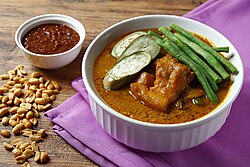 A bowl of kare-kare | |
| Course | Main course |
|---|---|
| Place of origin | Philippines |
| Serving temperature | Hot |
| Main ingredients | Oxtail, peanut sauce, vegetables |
| Variations | Goat meat kare-kare |
Kare-kare is a Philippine stew (kare derives from "curry") that features a thick savory peanut sauce. It is generally made from a base of stewed oxtail, beef tripe, pork hocks, calves' feet, pig's feet or trotters, various cuts of pork, beef stew meat, and occasionally offal. Vegetables, such as eggplant, Chinese cabbage, or other greens, daikon, green beans, okra, and asparagus beans, are added. The stew is flavored with ground roasted peanuts or peanut butter, onions, and garlic. It is colored with annatto and can be thickened with toasted or plain ground rice.[1][2] Variations of kare-kare can be made with seafood, such as prawns, squid, and mussels, or exclusively from vegetables.
Condiments and other flavorings are usually added. It is often eaten with bagoong (shrimp paste), sometimes spiced with chili, ginisáng bagoóng (spiced and sautéed shrimp paste), and sprinkled with calamansi juice. Other seasonings are added at the table. Variants may include goat meat or (rarely) chicken.
Traditionally, most Filipino fiestas have kare-kare.[3]
A more modern twist on the classic Filipino kare-kare uses a different dish as the main meat for this dish. Pork is one of the most economical and easiest meats to cook. The most common meats repurposed for kare-kare are lechon (which is also used for lechon kawali)[4] and crispy pata (crispy pork shank). Alternative main proteins are tofu, beef chuck, beef shank, maskara ng baka, or cartilage from the cow's face, and tripe.[5]
- ^ "Kare-Kare: Filipino ox tail stew".
- ^ "Kare-Kare Recipe".
- ^ "Philippines: Kare Kare". 196 flavors. January 7, 2019. Retrieved March 5, 2020.
- ^ Santos, Rachelle (June 9, 2011). "Lechon Kawali Kare-Kare". yummy.ph. Retrieved August 1, 2021.
- ^ "Kare Kare Recipe". Panlasang Pinoy. Retrieved November 7, 2021.